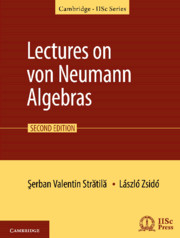Book contents
- Frontmatter
- Dedication
- Contents
- Preface to 2nd edition
- Preface to 1st edition
- Introduction
- 1 Topologies on spaces of operators
- 2 Bounded linear operators in Hilbert spaces
- 3 Von Neumann Algebras
- 4 The geometry of projections and the classification of von Neumann algebras
- 5 Linear Forms on Algebras of Operators
- 6 Relations Between a Von Neumann Algebra and its Commutant
- 7 Finite Von Neumann Algebras
- 8 Spatial Isomorphisms and Relations Between Topologies
- 9 Unbounded linear operators in Hilbert spaces
- 10 The theory of standard von Neumann algebras
- Appendix
- Bibliography
- Subject index
- Notation index
Introduction
Published online by Cambridge University Press: 26 April 2019
- Frontmatter
- Dedication
- Contents
- Preface to 2nd edition
- Preface to 1st edition
- Introduction
- 1 Topologies on spaces of operators
- 2 Bounded linear operators in Hilbert spaces
- 3 Von Neumann Algebras
- 4 The geometry of projections and the classification of von Neumann algebras
- 5 Linear Forms on Algebras of Operators
- 6 Relations Between a Von Neumann Algebra and its Commutant
- 7 Finite Von Neumann Algebras
- 8 Spatial Isomorphisms and Relations Between Topologies
- 9 Unbounded linear operators in Hilbert spaces
- 10 The theory of standard von Neumann algebras
- Appendix
- Bibliography
- Subject index
- Notation index
Summary
In the study of operator algebras, there are two main methods, the first is of an algebraic character whereas the second is more analytic.
The algebraic method proceeds by a successive reduction of problems concerning the arbitrary operators to problems about positive operators and from these to problems about projections, where one can avail oneself of the lattice-theoretical geometry of projections. In this geometry, the main notion is that of equivalence, and the main result is the comparison theorem, an important technical device being the polar decomposition of operators. These methods are elementary, but they afford a clear classification of the von Neumann algebras into general types. The results obtained by these methods are shown in Chapter 4 and in the first sections of Chapter 7.
The analytic method, which is more complex and profound, consists of a systematic manipulation with linear forms defined on operator algebras; they may be bounded or unbounded. Here the important facts are concentrated around certain results which extend the classical Lebesgue–Radon–Nikodym theorem, the main technical tool here being the polar decomposition of linear forms. The analytic methods permit the analysis of relations existing between the given algebra and its commutant, as well as of those that relate the predual of the given algebra to the Hilbert space in which this algebra is operating. Chapter 6 shows the relations existing between the type of the given algebra and its commutant, whereas Chapters 7 and 8 exhibit the quantitative relations that measure the relative wealth of the given algebra and its commutant. For finite von Neumann algebras, the existence of a trace, which measures the relative dimension of projections, allows the evaluation of the quantitative relations between the given algebra and its commutant by a coupling function of a metric nature. In other, more general, cases, the coupling between the given algebra and its commutant can be measured only by projective objects, namely cardinals associated with central projections, but the information thus obtained is not always satisfactory.
The von Neumann algebras that are well equilibrated with their commutants are called standard von Neumann algebras, and the main result of Chapter 10 is that any von Neumann algebra is isomorphic to a standard von Neumann algebra in a canonical form.
Information
- Type
- Chapter
- Information
- Lectures on von Neumann Algebras , pp. 1 - 3Publisher: Cambridge University PressPrint publication year: 2019
